Cooking pasta is really very easy, until it goes wrong. And then it’s a disaster!
But if you follow a few simple rules, there is no reason why it need ever be troublesome.
The rules really are very simple:
1. Use a BIG pot
2. Boil lots of water (Cover the pot — the water will boil faster)
3. Add salt when the water comes to the boil
4. Put in your pasta and bring it back to the boil
5. Give the pasta a stir
6. Cook the pasta for no longer than it says on the packet.
1 and 2. Use a BIG Pot and boil lots of water.
The first mistake people make when cooking pasta is the size of their pot. Pasta needs a lot of space to move around in while it cooks. If it doesn’t have this space, then there’s a good chance that the pasta will stick together or to the sides of the pan, with disastrous consequences.
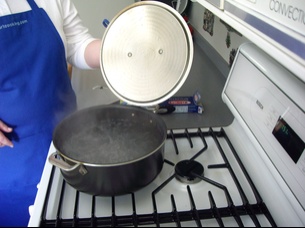
Technically, 1 pound of pasta yields 8 servings, according to what most boxes say. However, in my family it’s usually 4 servings! What can I say…hearty appetites!
To cook 1 pound of pasta, it is recommended that you use 4 quarts of water. That means you will need a 6-quart pot. (In addition to the water, the pasta needs to fit in as well.) If you cook a lot of pasta it is worth investing in a big pot – it’s also really useful for other dishes, especially for making soups.
Even though we are going to be bringing the water to a boil, be sure to start off with cold tap water. Apparently, hot water enables the impurities in the pipes to come through the pipes faster.
3. Add salt to the water when it comes to the boil.
The addition of salt is vitally important to the cooking process, as it ensures even cooking throughout the depth of the pasta. If you don’t add salt the pasta acquires a slimy texture when cooked. But don’t add it too early or it will just make the pot take longer to come to a boil.
You need to add 2 tablespoons of salt to the water when cooking pasta for four, (oops I mean eight.)
Very little of the salt stays with the pasta when it is served. (It stays in the cooking water.) So those on a low salt diet don’t have to worry too much about the amount of salt that goes into the water.
4 and 5. Put in the pasta all at once and bring it back to the boil.
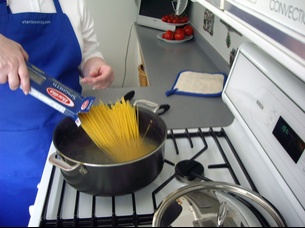
As the pasta comes back to the boil, give it a good stir with a wooden spoon, a pair of long tongs, or a spatula to make sure that none of the pasta is sticking together.
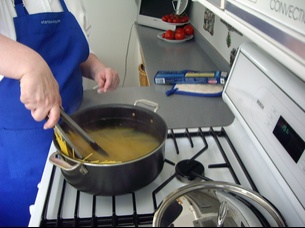
6. Cook the pasta for no longer than it says on the packet.
When the water comes back to the boil start your timing. This is VERY important. (I use a timer that beeps at me after the set timing.)
On the packet will be the cooking time for that particular pasta. Do be aware that different manufacturers’ times are different – even for the same type of pasta.
Once the pasta is getting near the set time it should be ready, lift out a piece of pasta with a fork or a pair of tongs and bite it to see if it is cooked. The pasta is cooked when it is slightly firm to the bite, a condition called al dente.
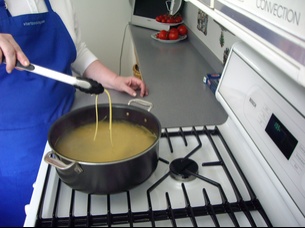
Repeat the biting test as the pasta nears the point of perfection. As soon as this point is reached, you should stop cooking straight away and drain the pasta through a colander. Don’t overcook pasta!
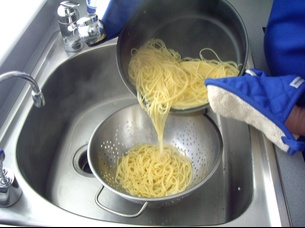
You don’t want the pasta to sit around once it’s cooked. It will go soggy, so be ready to serve up your pasta and sauce as soon as the pasta is cooked.
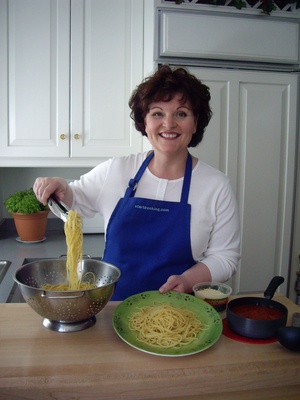
Some people recommend that you put oil in the water when you add the salt (step 3). I really don’t recommend adding oil because while it may stop the pasta sticking, pasta that’s cooked in oily water will become oily itself. As a result, the sauce slides off, doesn’t get absorbed, and you have flavorless pasta.
Oh, and by the way: Tossing the strand of spaghetti on the wall to see if it sticks is not my way of checking for tenderness. Let’s just say I have heard it has been done that way.
Enjoy your pasta! Any questions?
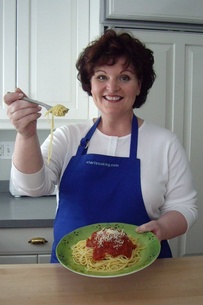
Cooking Pasta Ingredients:
(6-8 Servings)
- 1 pound of pasta
- 4 quarts of water
- 2 tablespoons of salt
If you are new to startcooking, or are a regular visitor here, please consider subscribing for free.








































Sara Sweetser said:
Hi auntie kathy!!! I have been lurking for so long I thought I should write. I have learned so much from this site so far!! One piece of advice I do have is never try low carb pasta!! It tastes like paste. Keep up the good work, I love reading your blogs.